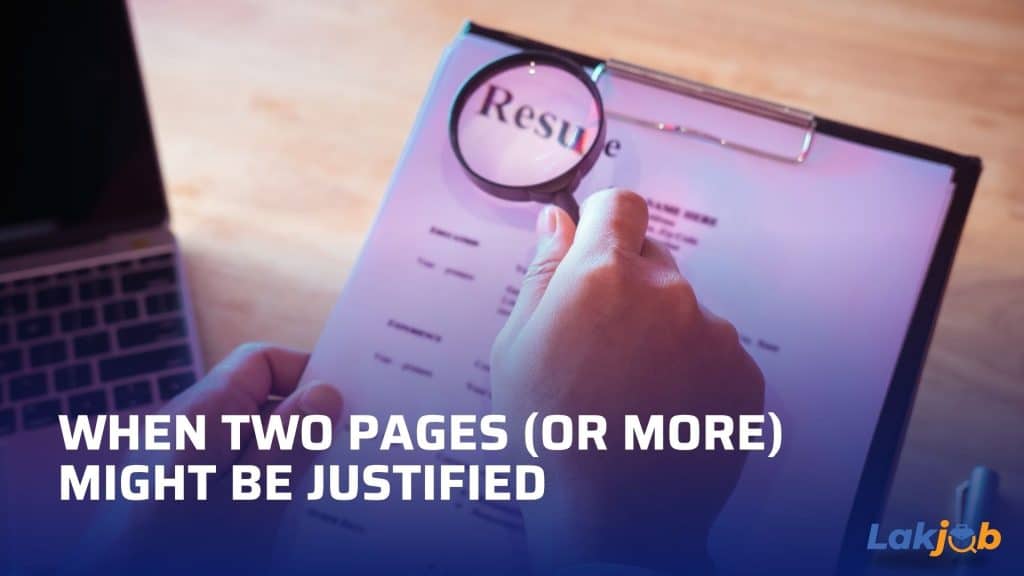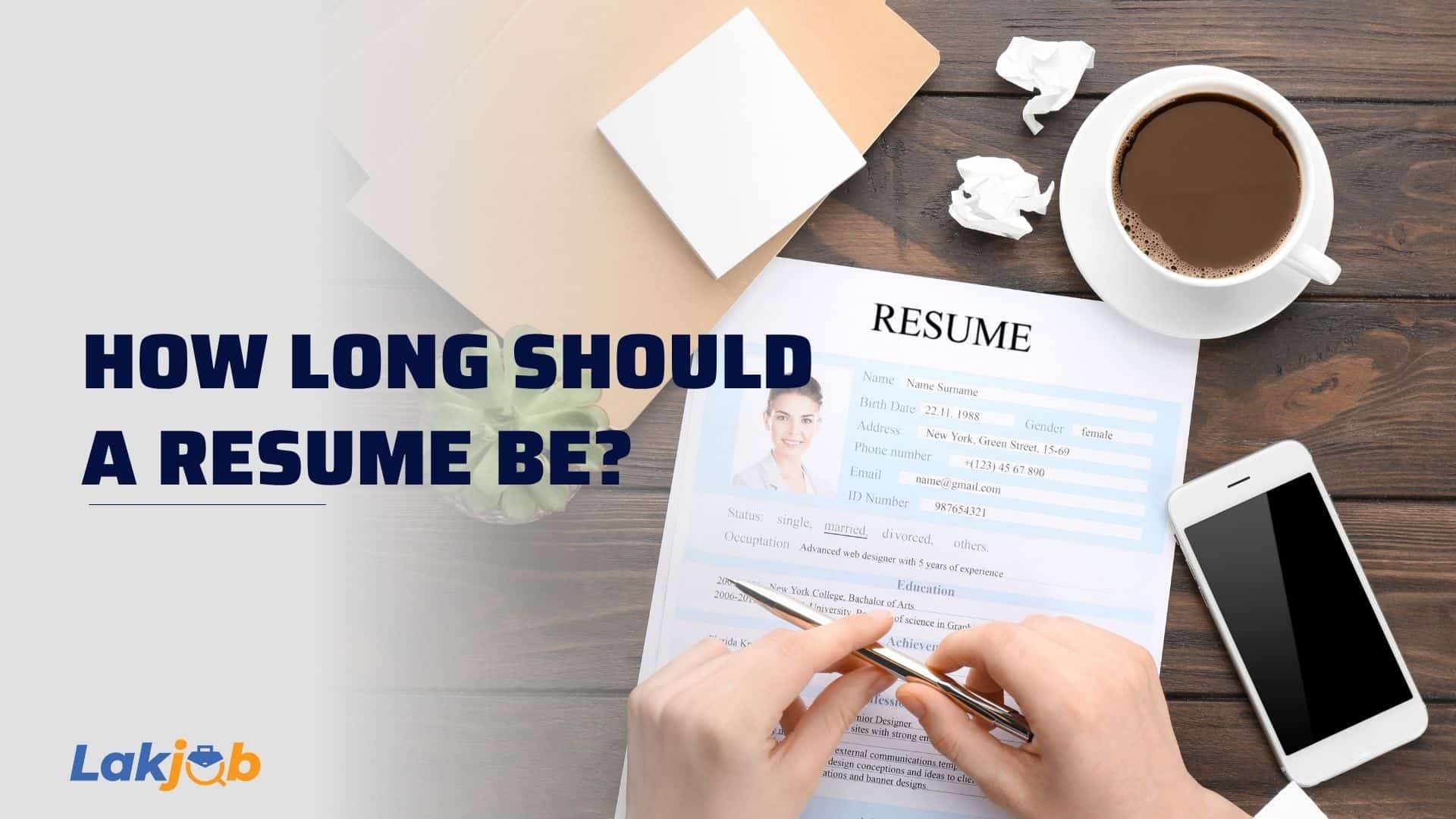Stepping into the U.S. job market as a recent graduate or student often brings a flurry of questions.
You’ve diligently compiled your academic achievements, projects, and limited experiences, but then a crucial question arises: How long should a resume be?
This seemingly simple query can spark significant anxiety, especially when you’re aiming for an entry-level position with a desire to showcase your full potential.
Should it be a concise one-page document, or can you expand to two pages to fit everything?
This guide will demystify resume length, providing actionable insights rooted in recruiter expectations and Applicant Tracking System (ATS) realities, empowering you to craft a perfectly optimized resume that opens doors to exciting entry-level opportunities across the United States.
The Golden Rule for Recent Graduates: One Page is Preferred (and Why)

For most recent graduates and students applying for their first or second entry-level job in the U.S. market, the overwhelming consensus among career experts and recruiters is clear: your resume should ideally be one page.
This “golden rule” isn’t arbitrary; it’s rooted in the fast-paced nature of modern hiring.
Why Recruiters Prefer One Page:
- Limited Attention Span: Recruiters are often sifting through hundreds of applications daily. Studies show they spend an average of 6-7 seconds initially scanning a resume. A one-page document allows them to quickly grasp your most relevant qualifications.
- Conciseness & Focus: A single page forces you to be concise, strategic, and prioritize the most impactful information. This demonstrates your ability to communicate effectively and get straight to the point—a valuable professional skill.
- Relevance for Entry-Level: For candidates with limited professional work experience, there’s typically not enough highly relevant, quantifiable achievement to justify more than one page. Anything beyond that risks appearing as “filler.”
- ATS Compatibility: While ATS can process multi-page resumes, a clean, single-page format often minimizes parsing errors and ensures all critical information is visible without extensive scrolling or navigation.
Insight: Your goal as a recent graduate is to make it as easy as possible for a recruiter to see why you are a good fit within those crucial first few seconds. A concise, impactful one-page resume achieves this.
When Two Pages (or More) Might Be Justified: Understanding the Exceptions

While the one-page rule is paramount for most entry-level candidates, there are specific scenarios where a two-page resume (or, rarely, more) might be acceptable or even necessary.
These exceptions typically apply to more experienced professionals or highly specialized new graduates.
For More Experienced Professionals:
- 10+ Years of Relevant Experience: If you have a decade or more of progressive, relevant experience with significant achievements, a two-page resume is standard.
- Executive or Senior Leadership Roles: Positions requiring a long history of complex leadership and quantifiable impact often necessitate more space.
- Extensive Publications/Presentations: Academics, researchers, or those in specialized fields with numerous published works or speaking engagements may use longer resumes (sometimes even a CV, which is different from a resume).
Rare Exceptions for Recent Graduates:
Even for new graduates, a second page might be justifiable in very specific, limited circumstances, but this is rare and requires careful consideration.
It’s only warranted if you have:
- Highly Technical Roles with Extensive Relevant Projects: For fields like highly specialized engineering, scientific research, or advanced data science, if you have multiple, complex academic projects or research experiences that are directly relevant to the job and include significant quantifiable results, a second page might be needed to detail these.
- Multiple, Significant Internships in Different Relevant Fields: If you’ve completed 3+ distinct and impactful internships that are all highly relevant to the role and showcase a wide range of skills and achievements, you might need a second page to do them justice.
- Dual Degrees with Diverse, Relevant Projects: If you have dual degrees from different disciplines, and robust, distinct projects from both are directly applicable to the job.
Crucial Caveat: For recent graduates, always ask yourself: “Does this second page contain information that is absolutely essential for this specific job, and is it more impactful than anything I could condense on the first page?” If the answer isn’t a resounding “yes,” stick to one page. The risk of overwhelming a recruiter usually outweighs the benefit of adding extra details.
The Art of Condensing: Making Every Word Count

Achieving a powerful one-page resume requires strategic editing and a ruthless commitment to conciseness.
This isn’t about simply shrinking your font; it’s about optimizing your content for maximum impact.
Actionable Tips for Condensing Your Resume:
- Prioritize Relevance: Every bullet point, every skill, every detail must directly support your candidacy for this specific job. If it’s not relevant, cut it.
- Quantify Everything: Numbers and metrics are concise and impactful. Instead of “Responsible for social media,” write “Managed 3 social media accounts, increasing engagement by 25%.” This says more with fewer words.
- Use Strong Action Verbs: Start every bullet point with a powerful action verb (e.g., Developed, Led, Analyzed, Streamlined). Avoid passive phrases like “Assisted with” or “Responsible for.”
- Combine & Streamline:
- Combine Similar Points: If you have multiple bullet points detailing similar tasks, consolidate them.
- Remove Redundancy: Ensure you’re not repeating the same skill or achievement in different sections.
- Eliminate Jargon/Fluff: Avoid overly wordy descriptions or industry jargon that doesn’t add clarity.
- Be Selective with Dates: For part-time jobs or older experiences, you might only need to include the years, not full months.
- Concise Education Section: Beyond your degree, university, and graduation date, only include 3-5 most relevant courses or significant projects. Omit high school details if you have college experience.
- One Professional Summary/Objective: Keep your opening statement to 2-4 compelling sentences, focusing on your value proposition to the employer. For powerful examples and guidance on crafting this crucial section, explore Resume Objective Examples for First Job.
Insight: Think of your resume as a highlights reel, not a full documentary.
You want to pique their interest enough to earn an interview, where you can then elaborate.
Strategic Content Selection: Relevance is King
Deciding what to include (and therefore, what to cut) is perhaps the most critical aspect of managing resume length.
For recent graduates, this means looking beyond traditional job titles and focusing on the skills and experiences that truly align with entry-level roles.
What to Prioritize:
- Tailored Content: Your resume must be customized for every job application. Analyze the job description for keywords, required skills, and responsibilities, then ensure your resume reflects these.
- Transferable Skills: These are abilities gained from any experience (academic, volunteer, personal, part-time) that are valuable in a professional setting (e.g., communication, problem-solving, teamwork, digital literacy, organization). Explicitly state and demonstrate them.
- Relevant Academic Projects: Detail significant projects from your coursework, especially capstones or those involving real-world application. Describe your role, the tools used, and the outcomes.
- Internships & Co-ops: These are gold. Treat them like professional roles, detailing responsibilities and quantifiable achievements.
- Volunteer Work & Extracurricular Leadership: Highlight roles where you demonstrated initiative, teamwork, leadership, event planning, or specific skills. Quantify impact.
- Relevant Part-Time/Summer Jobs: Focus on transferable skills gained (e.g., customer service, time management, problem-solving, cash handling) rather than just job duties.
- Professional Certifications & Online Courses: List any credentials (e.g., Google Career Certificates, HubSpot, Coursera specializations) that directly relate to the job’s required skills.
- Relevant Coursework & Academic Honors: Beyond your degree, list 3-5 courses highly pertinent to the job. Include Dean’s List or Latin honors if applicable.
What NOT to Include (Common Mistakes for Length):
- Objective Statements (if generic): Use a summary or hybrid objective instead.
- “References Available Upon Request”: Assumed, wastes space.
- Irrelevant Hobbies/Interests: Unless directly related to the job’s skills.
- High School Information: If you have a college degree or significant post-secondary education.
- Outdated/Unrelated Work Experience: Jobs from many years ago, or those with no transferable skills whatsoever.
- Personal Information: Age, marital status, photo, SSN, etc.
- Excessive Personal Pronouns: “I,” “me,” “my” in bullet points.
- Repetitive Information: Saying the same thing multiple times in different ways.
Insight: Every element on your resume should contribute to building a compelling case for your candidacy. If it doesn’t, it’s taking up valuable space that could be used for something more impactful.
Formatting for Conciseness: The Visual Impact
Effective formatting isn’t just about aesthetics; it’s a powerful tool for managing resume length and enhancing readability.
A well-formatted resume uses visual cues to guide the recruiter’s eye and present information efficiently.
Tips for Optimizing Length Through Formatting:
- Strategic Use of White Space: Don’t cram everything. Enough white space makes your resume less overwhelming and easier to read. Use it around sections, between bullet points, and around headings.
- Font Choice & Size:
- Professional Fonts: Stick to clean, readable fonts (e.g., Calibri, Arial, Times New Roman, Garamond).
- Size: Use 10-12pt for body text and 14-18pt for your name and section headings. Going smaller than 10pt for body text makes it hard to read.
- Margins: Standard margins are 0.5 to 1 inch on all sides. You can adjust slightly within this range to gain space, but avoid making them too narrow (less than 0.5 inches) as it looks cramped.
- Concise Bullet Points: Aim for 1-2 lines per bullet point. Avoid dense paragraphs. Use strong action verbs to start each point.
- Layout & Columns: While simple single-column layouts are safest for ATS, if you use a two-column layout (e.g., for contact info/skills in a sidebar), ensure it’s a very clean, ATS-friendly template that doesn’t break parsing.
- Consistent Formatting: Maintain uniform spacing, bolding, and capitalization throughout. Inconsistencies look sloppy and distract.
- No Photos or Graphics: Avoid embedding photos, elaborate logos, or complex infographics, as these take up significant space and can cause ATS errors.
Insight: A clean, well-organized layout screams “professional” and helps the recruiter quickly identify key information, even if it’s packed efficiently.
Conclusion: Your Powerful, Concise Story
The question of how long should a resume be is more about quality than quantity.
For recent graduates and students venturing into the U.S. job market, the answer is overwhelmingly: one page.
This concise format forces you to be strategic, prioritize impact, and communicate your value with precision.
By mastering the art of condensing, ruthlessly selecting relevant content, leveraging your diverse experiences (academic projects, internships, volunteer work), and optimizing your formatting, you transform your resume into a powerful, ATS-friendly document.
Remember, your resume is a marketing tool, not a biography. It’s designed to pique interest and secure an interview.
Arm yourself with this strategic approach, and confidently step forward.
Your ability to present a compelling, focused story will undoubtedly open doors to your first professional success.
F.A.Q
Q1: What is the ideal resume length for a recent graduate applying for an entry-level job?
A1: For most recent graduates and students, the ideal resume length is one page. Recruiters spend very little time on initial scans, so a concise, impactful single-page document ensures your most relevant qualifications are immediately visible and digestible.
Q2: When is it acceptable for a recent graduate’s resume to be two pages?
A2: A two-page resume for a recent graduate is rarely justified and only in specific, limited circumstances. This might include highly technical roles with multiple, extensive, and directly relevant academic projects or research, or if you’ve completed 3+ significant internships in diverse, relevant fields that cannot be condensed to one page without losing critical impact.
Q3: How can I make my resume fit on one page without sacrificing important information?
A3: To fit on one page, prioritize relevance, quantify achievements, and be concise. Focus on only the most impactful experiences (academic projects, relevant part-time jobs, volunteer work). Use strong action verbs, combine similar bullet points, and eliminate jargon or repetitive information. Ensure your education section is concise, listing only key details and relevant coursework.
Q4: Does resume length affect whether it passes Applicant Tracking Systems (ATS)?
A4: While ATS can technically process multi-page resumes, a clean, single-page format often minimizes parsing errors. The main concern for ATS is keyword matching and consistent formatting, which are easier to maintain in a concise document. The primary reason for sticking to one page is human recruiter preference for quick scanning.
Q5: Is it better to have a slightly longer resume that includes all my experiences, or a very short one that leaves some out?
A5: For entry-level roles, it’s better to have a concise, impactful one-page resume that strategically highlights your most relevant and compelling experiences, even if it means omitting some less relevant details. The goal is to pique a recruiter’s interest with quality over quantity. Overwhelming them with excessive information can lead to your resume being overlooked.
I specialize in managing and auditing end-to-end HR functions, ensuring full compliance with state and federal regulations. I partner with leadership to drive strategic HR initiatives and implement necessary changes. My core strength lies in identifying, hiring, and training top talent to enhance team performance and support organizational growth.






